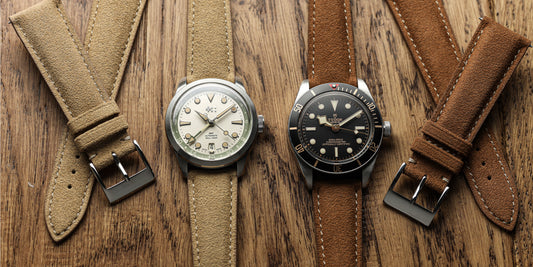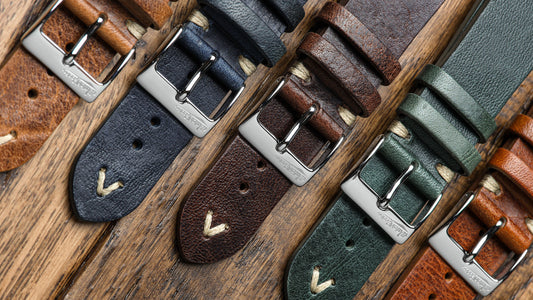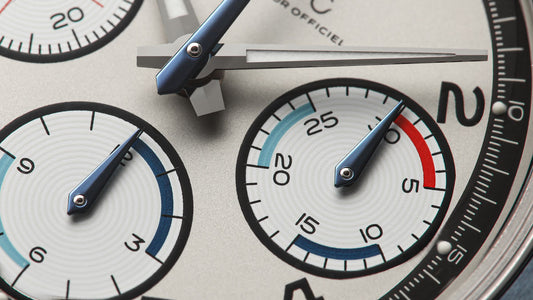Let's explore the military chronograph, concentrating on chronograph wristwatches used for military purposes by ground forces...
From researching this article, it's clear that trying to categorise military chronographs intended specifically for ground troops is hard. Much harder, in fact, than categorising, say, aviation or motorsport chronographs by their primary purpose. Try it! Omega Speedmaster? A motor racing watch that became the ultimate pilot chronograph when it flew to the moon. No doubt there. Another example? The Breguet Type 20 Flyback Chronograph? Primarily a pilot's watch – no argument there either. Now try this with any chronograph wristwatch that you've historically associated with land forces? It's not easy, so please read on...

The purest military chronographs for ground forces?
At the time of the First World War, wrist chronographs with telemeter scales were mainly for ground use. Even then, standalone telemeters and pocket watch chronographs were widely used by artillerymen. Wristwatch chronographs weren't the sole artillery rangefinder's timepiece – they were simply too new. Maybe then, the WW1-era telemeter wrist chronographs were the purest chronograph wristwatches for ground forces. Perhaps everything after that was just an adaptation of a motoring or aviation chronograph? Let's see...

Aviation timekeeping has clearly been the main role of military chronographs since the early twentieth-century. Furthermore, many wrist chronographs used by ground forces were primarily conceived for aviation. In Dr Konrad Knirim's Militäruhren (an excellent German military watch resource), there aren't many military chronograph wristwatches for ground troops amid the pocket watches and aviation chronographs. Examples quoted include the sidereal time Heuers and Tutima's 5100 BWL 2 used by Bundeswehr ground forces since the 1950s. But then again, these were chiefly aviation chronographs bought for Germany's post-war air force...
Defining and identifying military chronographs that primarily used by land forces is difficult – maybe impossible. Often, 'military chronographs' of this type are just wrist chronographs (often procured primarily for aviation use) used by ground forces rather than dedicated 'army watches'. What's more, a century after WW1 many military (tactical) watches are simple three-handers with 24-hour numbering. Nowadays, it's also much rarer for governments to source military watches. In fact, it's generally left to individuals.
The story begins with the First World War
The result is a pool of increasingly rare and valuable vintage chronographs that were (or may have been) used by ground troops in the past. They sit alongside modern watches that draw on land-based military heritage to some extent – but rarely in the way their military diving and aviation contemporaries draw on operational use. Thirdly, the modern marketplace is rich with chronograph watches combining real or perceived military functionality with characteristics desired for general-purpose sports or outdoor-activity. Identifying military chronographs with genuine ground warfare history, or that were specifically designed for this, is difficult. The story, as for men's wristwatches and military wristwatches in general, begins with World War 1...

The wristwatch we know today emerged from late nineteenth-century wars where troops adapted pocket watches into 'wristlets'. By WW1, wristwatches were slowly gaining credibility with men – largely due to military and aviation use. If one event cemented the acceptability of wristwatches for men, it was this war. The Great War also drove innovation in watch design. Developments in practical functions such as luminosity, bezels, chronograph mechanisms, waterproofing and synchronisation determined the wristwatch aesthetic that remains today.
The modern chronograph wristwatch is born
Though wrist chronographs with telemeter scales existed during WW1, pocket watches were still widely used, but change was afoot. In Wristwatches: History of a Century's Development, Kahler, Mühe and Brunner say: 'A Belgian watchmaker had written as early as 1912 that the wristwatch, being so practical and useful, would undoubtedly become more popular among men as well as women. A German colleague, under the influence of [WW1] came to the conclusion that: "Nobody can still doubt that all those who did not want to believe that the wristwatch had a future, including all the experts in the watchmakers' shops, have been proved wrong." '
Increased adoption of wristwatches, including chronograph watches, had established the value of such timepieces for future military and civilian use.
Use of military chronograph watches in WW1 helped establish such watches for future sports, industrial and military roles. It also contributed to a new, defining identity for wristwatches that took them beyond merely being smaller, wrist-worn pocket watches.
Kahlert, Mühe and Brunner again:...'wrist chronographs had places of honor in many displays and outdid each other in watertightness, resistance to magnetic fields and refinements of their measuring abilities...'
When Gaston Breitling took over Breitling in 1914, he quickly appreciated the advantages of wristwatch chronographs for military personnel. A year later he introduced the first chronograph wristwatch with a separate pusher. This innovation, standing alone at 2 o'clock instead of within the main crown, transformed chronograph watches. To quote the contemporary Revue internationale de l'horlogerie et des branches annexes, '...[the pusher] is more easily reached and so makes the observation more practical and reliable.' The modern military chronograph wristwatch was born.

Image courtesy of Fratello Watches / www.fratellowatches.com
How does a watch telemeter scale work?
That 1915 Breitling was advertised as a Bracelet Chronographe-Compteur. But without the telemeter that would soon be a defining characteristic of wrist chronographs.
In The Wristwatch Handbook, Ryan Schmidt writes, '...the telemeter was a key tool for calculating firing ranges.' As we've seen, both sides in WW1 used standalone and hand-held optical telemeters for range finding. However, though optical rangefinders had existed for decades, telemeters on military pocket watches, and to a lesser degree wrist chronographs, were still widely used.
So what is the acoustic telemeter that's a characteristic of so many chronographs? It deserves a brief explanation.
Until WW1, various standalone and hand-held optical rangefinders were used by infantry, cavalry and artillery. From 1892 when Theodore Schaedeli invented the telemetric chronograph, so were pocket watches. Later, though not replacing telemeters, the wrist-worn telemeter watch brought new convenience to range finding. It was a microcosm of the overall changes brought to all military timing by the new acceptance of men wearing wristwatches.
Whether a telemetric chronograph is a pocket or wristwatch, a central chronograph hand indicates on a calibrated scale on the dial or rehaut. Unlike optical devices, telemetric chronographs work because sound and light travel at different speeds. To discover range, the chronograph is started when a gun flash is seen. When the corresponding report is heard, the chronograph is stopped and its hand shows the distance.
Nowadays, microwaves, lasers and other technology has replaced traditional optical or acoustic telemeters. Telemetric chronographs primarily remain as interesting legacy features.
We're not covering chronographs specifically designed for pilots here. But we were curious about the appearance of telemeters on aviation chronographs. When we asked Dr Konrad Knirim, an authority on German military watches and author of Militäruhren, about this, he wasn't aware of aviation applications for telemeter chronographs.
Other sources suggest that before modern onboard weather instrumentation, pilots on the ground may have occasionally used telemeter functions for calculating distances to thunderstorms storms.
Maybe the reason lies in estimating storm distances or reflects a feature originally intended for ground warfare. Either way, it's perplexing that most military chronographs used by ground forces – for instance the Heuer Bundeswehr – were designed primarily for flyers.
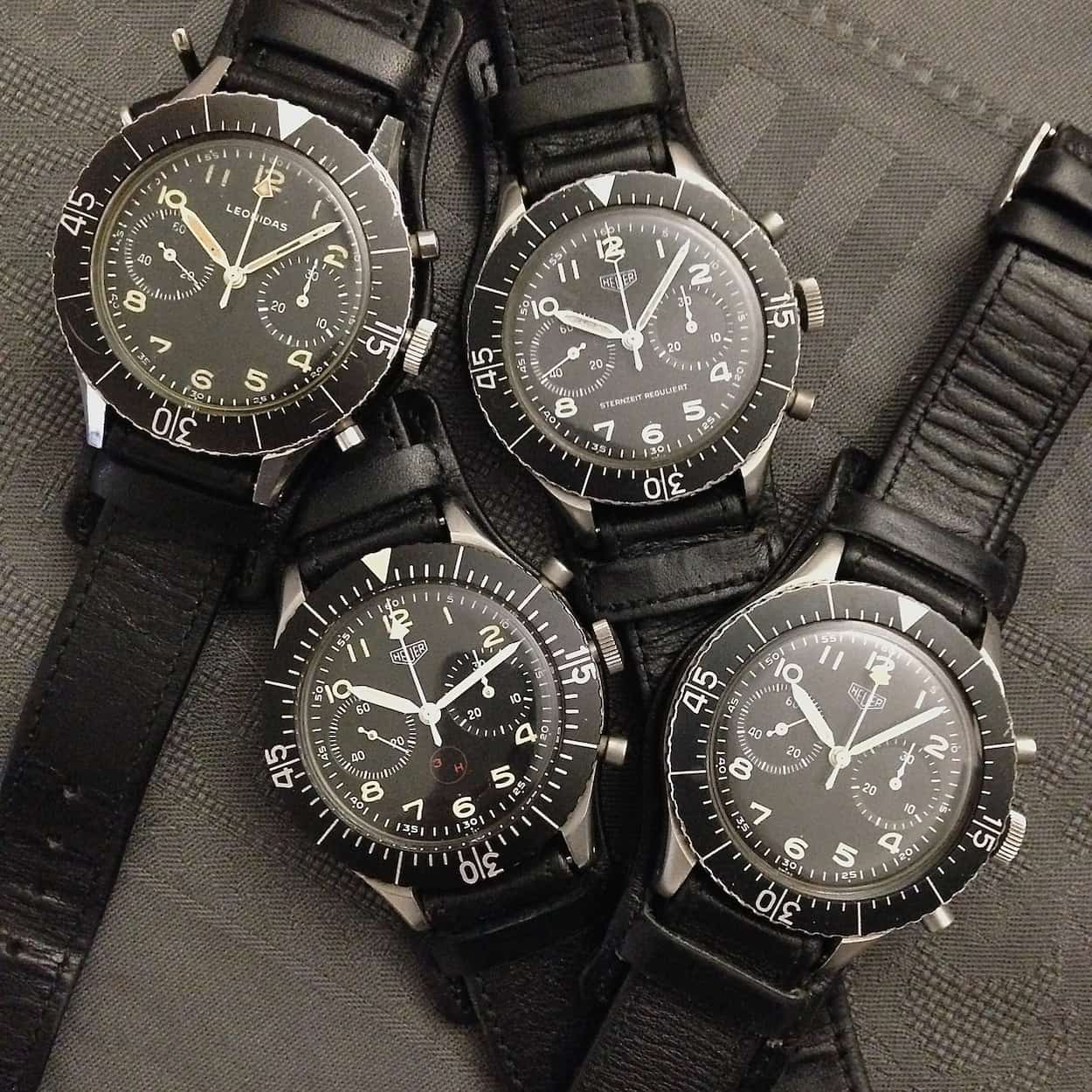
Image courtesy of Fratello Watches / www.fratellowatches.com
What defines ground forces' military chronographs?
By WW2, wrist chronographs, with their now-characteristic design language, were available from many companies. Single ('mono') and double pusher watches were available from companies whose names have now disappeared (such as Tronador and Gander) as well as others that remain familiar. For single-pusher chronos, two o' clock positioning was usual. However, there are interesting exceptions, such as a Pierce wrist chronograph with its mono pusher at four o' clock!
During our research, it became clear that military chronographs have long been more focused on aviation than ground forces. You need only search Google to see the predominance of aviation-related results. It's not surprising given the importance of timing tasks for navigation.
So what defines ground troops' military chronographs? During WW1, a telemeter scale would have been a key differentiator. Soon, with less military importance on this function, any differentiation between specifically ground and aviation watches was disappearing. The temptingly simple answer is that a military chronograph for ground forces is any chronograph watch used by them.
Another approach to defining ground troops' military chronographs is as watches issued to them by the military. Or how about a watch meeting military standards, such as UK DEF STANs?
Maybe 40 years ago, but by the late twentieth-century, armed forces were less likely to source and issue any watches, let alone expensive chronographs. In fact, stories abound of British preference for issuing a non-chrono wristwatch and a stopwatch rather than a chronograph. This is a reason British WW2 military chronographs, such as Army Air Observation crews' and artillery rangefinders' Orator watches, are so rare.

Image courtesy of classicheuers / classicheuers.blogspot.co.uk
Along with other similar standards, Britain's DEFSTAN 66-004 - 'watches, chronograph, wrist' was withdrawn in 1990. Nowadays, troops usually source their own watches, unless specialised timepieces are required for a specific mission.
Since WW2, as well as predominance of pilot and dive watches, ground forces' military watches have increasingly been simple, tactical watches. By the 1970s, four manufacturers dominated supply of British military chronograph wristwatches. So-called 'British military asymmetrical chronographs' were simple, reliable, black chronos with Valjoux 7733 movements. The vast majority were for air force and naval use. Around the world, the same aviation focus is apparent. Chronograph wristwatches simply aren't usually essential equipment for most soldiers.

Another reason in the demise of mechanical military chronographs is the emergence of cheap, reliable, digital watches. Brands include Casio (G-Shock), Traser, Luminox and Cabot Watch Company (CWC). Yet, though Cabot's website offers a CWC military chronograph, their general service watch collection doesn't.
Some of our favourite military chronographs...
Meanwhile, interest in 'military chronographs' continues unabated. Watch aficionados seeking affordable contemporary mechanical watches inspired by military heritage love them. So do dedicated collectors of vintage military watches. Even ordinary watch buyers seek reassurance from references to military heritage and 'tactical duty'. It exudes robustness and reliability that will complement their active – albeit civilian – lifestyles.
So here's our unashamedly subjective 'baker's dozen' of interesting military chronographs for ground troops. There's something for everyone, from outdoor lifestylers who only want one watch, to the most enthusiastic vintage watch collector. And from before WW1 to 2017!
You've probably heard of the 'Dirty Dozen' of British military watches. Well here's our 'baker's dozen' (13) of military chronographs. We believe the collection says lots about the evolution of ground forces' military chronographs. And we'd certainly love to own them. By the way, it's not a definitive list and if we've missed your favourite, please tell us in the Comments section.
Our first chronograph is from the year before WW1...
1. Longines 13.33Z Chronograph
This Longines military watch is a historically significant chronograph from 1913. Just before WW1, as well as pilots' watches, Longines made a strategic decision to create exceptional chronographs. This included one of the first chronograph movements developed specifically for wristwatches. It's the famous 13.33Z, with a triple-function stem at 3 o'clock.
2. Breitling Mono-Poussoir Chronographe-Compteur

Image courtesy of Breitling / breitling.com
In 1915, Breitling introduced the world's first chronograph with separate mono-pusher activation. With the Mono-Poussoir, Gaston Breitling not only stamped his mark on Breitling, but on chronograph history. Though perhaps lacking the 13.33Z's looks, the Mono-Poussoir marked another momentous breakthrough in chronographs.
With WW1 over, the inter-war years brought significant change to the world. There were the Roaring Twenties and Art Deco. And then the emergent Staatliches Bauhaus that would go on to influence design for decades. During this period, wristwatch sales overtook pocket watches for the first time. Automatic watches were developed and so were properly water resistant watch cases. And the popularity of wrist chronographs, with their tachometers and telemeters, grew...
3. Hanhart Kaliber 40
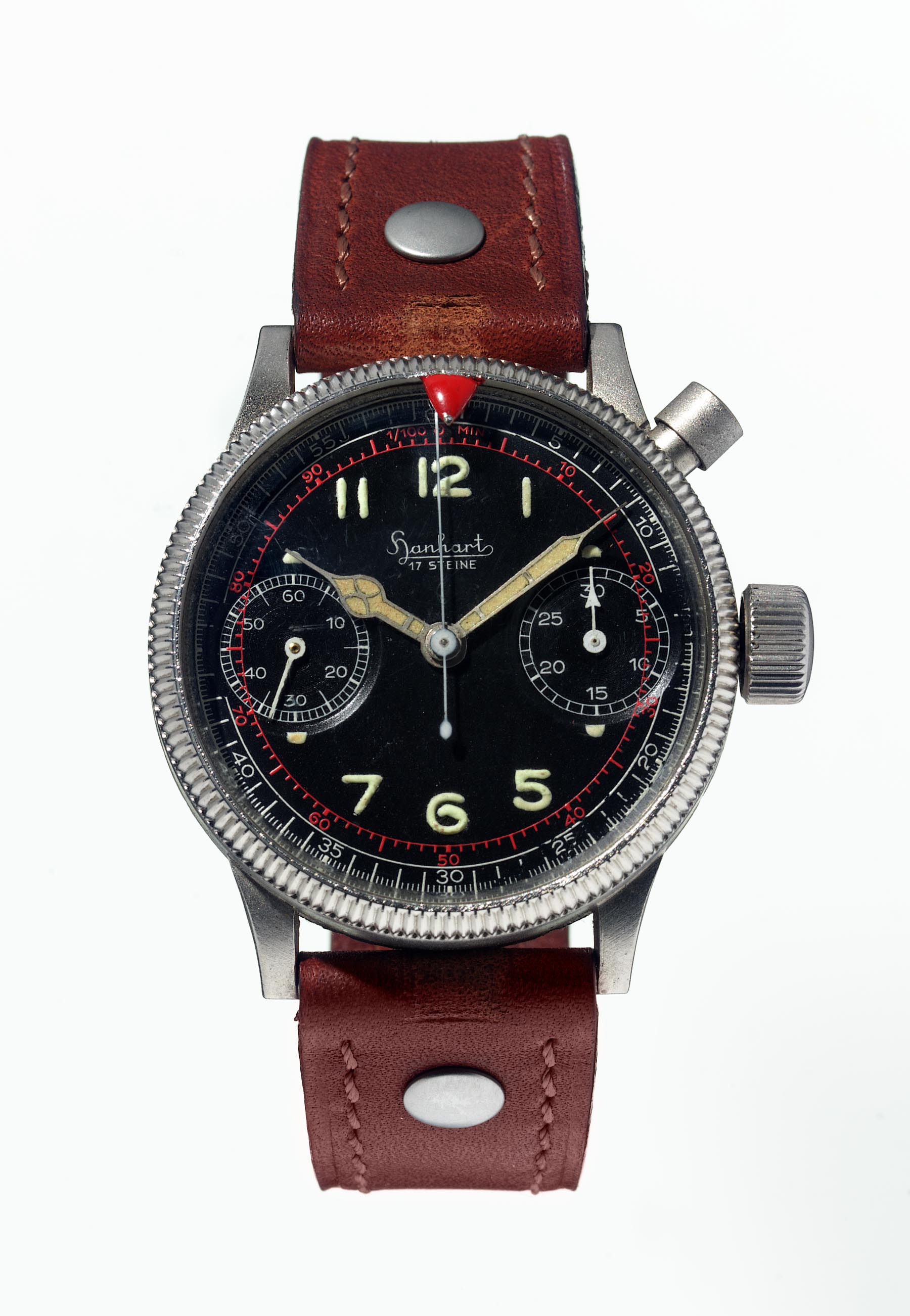
Image courtesy of Hanhart / hanhart.com
Now to a military chronograph that was state of the art on the eve of WW2. Hanhart's single-button chronographs for the Wehrmacht combined precision engineering with competitive price. Although primarily for the Luftwaffe, they were used across Germany's armed forces.
This was a time of proliferation of wrist chronographs from Hanhart, Heuer, Doxa, Tutima and many other manufacturers. As Gisbert Brunner and Christian Pfeiffer-Belli write in Swiss Wristwatches: Chronology of Worldwide Success, '...once again there was a war – and that was no longer imaginable without wristwatches.'
4. 1940s Heuer Chronograph ref. 349/c/Nch
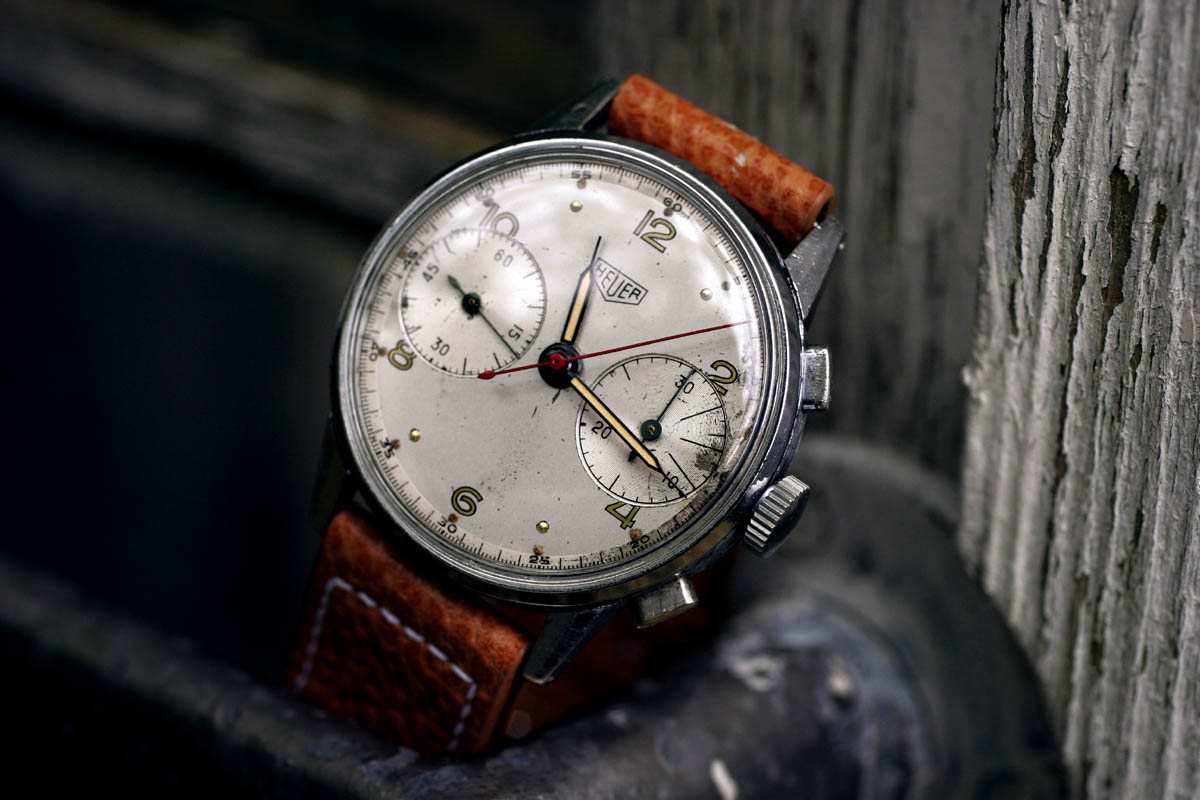
Image courtesy of classicheuers / classicheuers.blogspot.co.uk
Although strongly aligned with aviation, this snap-back Heuer military watch, powered by the Valjoux 72 with characteristic asymmetrical twin pushers, was used by ground forces too. An oft-reproduced advert from the 1940s bears this out with eight Swiss soldiers synchronising watches above a hero shot of a Heuer chronograph.
5. Mido Multi-Centerchrono

Image courtesy of carsandwatches.com / carsandwatches.com
Mido's distinctive Multi-Centerchrono is another significant 1940s mil-chronograph. Any watch originally advertised as '...the only chronograph that actually looks like a handsome watch – with all hands centred for easy reading...' deserves mention. In the best tradition of early military chronographs, this watch, with Mido's modified Valjoux caliber, has a telemeter scale. And on some versions, a military-style 24-hour scale too. Other appealing details include decagonal screw back case, faceted lugs and fluted sunburst pushers. Most interesting, however, is that this was probably the first wristwatch with a centralised chronograph where two centrally mounted hands replace chronograph subdials.
6. Heuer Bundeswehr Flyback Chronograph

Image courtesy of Fratello Watches / www.fratellowatches.com
A decade after the Mido's introduction, 1955 saw the formation of Germany's new unified armed forces (Bundeswehr). With this, the scene was set for another classic military chronograph. This is the 42 mm Heuer Bundeswehr 1550 SG (the Bund Heuer).
Though primarily intended for Luftwaffe pilots, this Heuer also served with artillery and reconnaissance units. Over a 35-year production life, several versions appeared, with at least five dial variations. The rarest (only 100–150 made) were marked 'STERNZEIT REGULIERT' (regulated sidereal time). This reflects the use of specialised sidereal timing for precise position-fixing by artillery gunners...
7. Heuer Military Autavia Ref 113.603.11063v
Our next watch, and the third Heuer military chronograph we're featuring, is the military version of another watch traditionally associated with motor racing.
In the 1970s and 1980s, Heuer's Autavia Cal 12 was supplied to the Israeli Defence Forces (IDF) – 'Tzahal' in Hebrew. Various movements, dials and finishes exist, all signed with the distinctive sideways 'M', the Hebrew letter 'Tzadi' that starts the word 'Tzahal'). Arguably, the most desirable examples are the black PVD-coated Autavias worn by Israel's Shayetet 13 special forces in the 1980s.
8. Orfina Porsche Design Chronograph 1

Image courtesy of acollectedman / acollectedman.com
Like the military Autavias, the Porsche Design Chronograph was originally a motorsport watch that only attracted military attention later. To quote Porsche Design's Baselworld 2017 catalogue: '...the story of its development takes us back to the racetrack. In order to prevent distracting reflections, in the late 1960s racing car cockpits began to be fitted with matte black instruments and white displays. Prof. F. A. Porsche seized on this idea and designed the world's first matte black watch.'
The 1972 PD 7177 drew on Orfina's military watch expertise with a sophisticated black PVD-coated chronograph. Apparently, the technology was originally developed for military helicopter rotors. The first 7177s were Valjoux 7750 powered. However, when Porsche and Orfina starting pursuing military contracts, this was replaced with Lemania's robust 5100. The Lemania's direct-driven chronograph was the only available chronograph movement up to the shocks, high G forces and minimal servicing of military use without noticeable accuracy loss. Germany's Bundeswehr, the Royal Navy, Swiss military, UAE Air Force, US Air Force and Venezuelan Ministry of Defence eventually procured versions of the 7177-M (Military).
9. Auricoste Valjoux 7765 (1980s)

Image courtesy of classicwatch.com / www.classicwatch.com
Another watch that was used by troops rather than aircrew is Auricoste's Valjoux 7765 chronograph. The manual-wind Auricoste, with its high-legibility white-on-black dials, was worn by France's elite 13e Régiment de Dragons Parachutistes. It's another rare watch that deserves being in any 'dream' military chronograph collection.
10. Breitling Colt (1980s)

Image courtesy of Breitling / breitling.com
Staying in the 1980s, but without the same clear use by ground forces, is another Breitling. According to brochures, the Colt was originally designed for supply to armed forces. Although this suggests use across all military branches, most references suggest predominantly aviation and marine use. Even 2016's Colt Chronograph Automatic Blacksteel (which '...boldly flaunts its military origins [and] high-tech Military fabric strap') doesn't have the mil-style 24-hour dial of some non-chronos. Our conclusion? The Breitling Colt's military positioning is more about marketing ('understated and efficient style') than serious operational intent.
11. Sinn EZM 1

Image courtesy of Deployant / deployant.com
That's certainly not an observation that can be made about Sinn Spezialuhren. From its foundation by Helmut Sinn in 1961, Sinn has been inextricably linked with aviation, military and paramilitary organisations.
In 1994, Lothar Schmidt, formerly of Porsche Design, IWC and Lange & Söhne, bought Sinn. This may explain family resemblances between the Lemania 5100-powered Sinn 157 and 1972's Orfina-Porsche Chronograph...
Sinn's military credibility is further validated by close association with Heuer Bund chronograph. Sinn handled post-production servicing for the Bundeswehr watches; some Heuers were even refurbished with Sinn dials.
More recently, the closest Sinn military chronograph to a military chronograph for ground forces was the now-discontinued Einsatzzeitmesser EZM 1 developed for Germany's Central Customs Support Group, ZUZ. Others include 2017's limited edition EZM 1.1, and the EZM 6 and EZM 13. However, the last two, despite mission timer designations, are primarily dive watches. All these (para) military chronographs are, or were, part of Sinn's mission timer portfolio. This is a range of watches developed for professionals ranging from firefighters to Germany's elite Police Tactical Unit, GSG-9.
More support for the notion that modern 'military chronographs' are just well-designed chronographs used in military contexts comes from Sinn's catalogue. It's packed with pilot chronographs, large pilot chronographs, space chronographs, sports chronographs, traditional chronographs, duochronographs, navigation chronographs, split-seconds chronographs and rally chronographs. But the only reference to explicit ground forces role for a chrono seems to be the 'military' green silicone strap on the 757 S UTC duochronograph!
12. Traser Officer Pro Chronograph
Today, most military watch choices are left to individuals. Quartz digital and analogue watches, such as Casio's G-Shock and mb-microtec AG's Traser brand, are popular for tactical applications. Traser offers officially licensed UK MOD products. But none of their 'military badged' range is a chronograph and only a few chronographs – including the Ronda-powered Officer Chronograph Pro grace their range.
13. Swiss Military Hanowa (SMH) Challenge Touchdown Chrono

Where Traser clearly exploits practical military links, our last military chronograph represents a different product class. This one seems to be more about combining the romance of military imagery with solid engineering for affordable mass market appeal.
Swiss Military Hanowa's Challenge Touchdown chronograph is included as the serendipitous result of the writer winning one in a competition. The timing was perfect because this Swiss military quartz watch represents the latest civilian-orientated manifestation of military chronographs.
To quote Hanowa, they've 'pushed the rugged aesthetic since 1963' when Hans Noll established the company. Unlike so many Swiss firms, Hanowa survived the quartz crisis. Later 'Swiss Military' was added to the name to emphasise alignment with the values of the Swiss armed forces and SMH became officially licensed by the Swiss Confederation. However, to the best of the author's knowledge – and unlike the ubiquitous Swiss Army Knife – Swiss troops aren't officially issued with watches for their military service.
The modern military chronograph
That's how timely arrival of an SMH Swiss military chrono, means the watch represents the popular notion of military chronographs as practical watches for modern lifestyles. It's a long way from the military imperatives that put chronograph watches on the wrists of WW1 troops.
As with other tool watches, modern military chronographs are expected to have certain features. Though rarely used for the reasons they were originally included in a watch specification, features such as chronographs, legible dial marking and bright lume are useful for other day-to-day reasons.
Features like telemeters and tachymeters, are also nice to have on a contemporary watch. Even if you never use them, they're what you expect to find on a fully-featured military chronograph. Knowing their original function and how to use it enhances ownership and connection with the chronograph's heritage.

In particular, telemeter scales (once usual on any 'proper' military chronograph) are now just interesting legacy features – unless it's that rare occasion when you really need to know how far away an approaching electrical storm is!
So, it looks as if the idea of the military chronograph is now more of a marketing property, drawing on long heritage to appeal to romantic civilian notions rather than being an essential front line tool.
As a final check on the current state of 'military chronographs', we reviewed a selection of leading watch brand catalogues. In the pages of brochures from brands as diverse as Longines, Hamilton, Bremont and IWC, we hoped to see how military chronographs for ground forces shape up against their counterparts for other specialisms. What we saw confirmed that wherever chronographs feature, the emphasis remains predominantly on aviation and motorsport.

As mentioned earlier, the EZM6 Mission Timer is probably the closest Sinn comes to a military chronograph for ground troops. Laco, another German manufacturer with military heritage, features a range of tactical watches (Einsatzuhren) – but none is a military chronograph. These, and other examples, clearly show how, over a century, military and paramilitary watches have gravitated to simpler, three-handers.
Hamilton's brochure mentions military heritage, including 1942's US Army Navy 'E' Award in association with its military-inspired Khaki Field Automatic Chronographs ('direct descendents of heroic forerunners that served the Forces in both World Wars.').
Conclusions
Our journey began a century ago when the idea of wristwatches for men remained as foreign and uncomfortable as the Somme's trenches. Now we end with some conclusions about the modern military chronograph.Firstly, although the need for wrist chronographs in these areas is as redundant as the role of wristwatch telemeters for artillery range finding, today's military chronographs are predominantly aviation orientated.
Secondly, a century ago wrist chronographs with telemeters had some practical military use. Nowadays, if present at all, they're an interesting legacy function alluding to a bygone age.

Thirdly, with a few exceptions, the importance of the military chronograph among military watches has given way to simpler three-handed tactical or field watch. And as we've seen, even that tends to be chosen by individual servicemen and women these days.
Next, as demonstrated by watches such as the Swiss Military Hanowa Challenge Touchdown chrono, the role of today's military chronograph is much more about military association, perceptions about what 'military' means and marketing to civilians with active lifestyles than explicit military use. As with many modern watches, the characteristics and features associated with military chronographs now give us watches with day-to-day functionality plus legacy functions.

Image courtesy of Fratello Watches / www.fratellowatches.com
Today's 'military chronograph' has a very different role compared with watches worn during twentieth-century conflicts. Nevertheless, the concept of a military chronograph for ground forces' operations is sure to keep on fascinating us. We're sure that will continue, whether the watch is a vintage 1915 Breitling, a Cold War-era Bund Heuer or today's respectful tribute to the chronographs that saw military service over the last 100 years...
So what do you think of our choice of watches? Do you agree with them? Have we omitted your favourite military chronograph for ground troops? Either way, or with any other thoughts, please use the Comments section to tell us.


